This Week in Science - June 3 - 9, 2013: Molecule appearances...
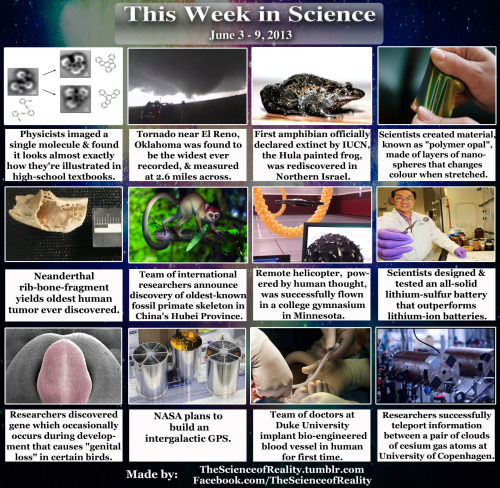
This Week in Science - June 3 - 9, 2013:
- Molecule appearances here.
- Widest tornado recorded here.
- Hula painted frog here.
- Polymer opal here.
- Neanderthal tumor here.
- Oldest fossil primate skeleton here.
- Thought powered helicopter here.
- Lithium-sulfur battery here.
- Genital "loss" in birds here.
- NASA intergalactic GPS here.
- Bio-engineered blood vessel here.
- Teleporting information here.
jtotheizzoe: Born Without a Windpipe, Now Breathing A Full...

Born Without a Windpipe, Now Breathing A Full Life
Hannah Warren has become the youngest person to ever receive a bioengineered tissue transplant, receiving a windpipe created from her own stem cells grown around a special plastic scaffold. This "proto-windpipe" is then recognized by the body, and (through processes that aren't entirely clear) a fully developed windpipe, complete with the many layers of specialized cells, is formed with the scaffold and stem cells as its guide.
I've posted about these bioengineered transplants in older patients before, but I think this captures the amazement we all feel:
Dr. Macchiarini described a look of befuddlement on the child's face when she realized that the mouth tube was gone and she could put her lips together for the first time. "It was beautiful," he said.
Yes. Beautiful, indeed. Way to go science.
(via New York Times)
Enjoy some nature gifs in HD. [Click images to...

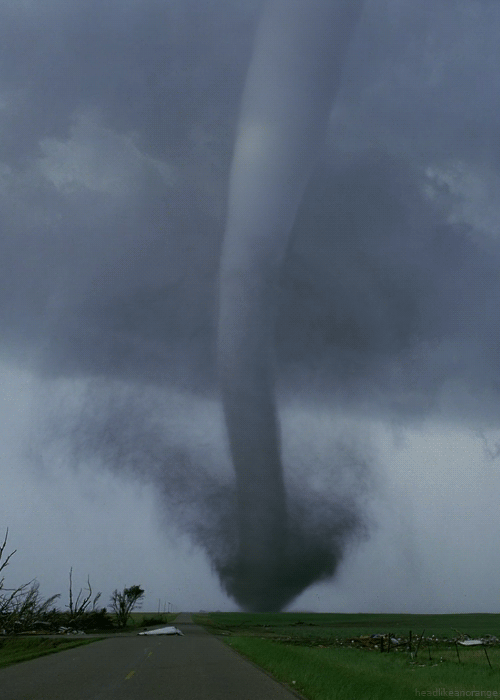



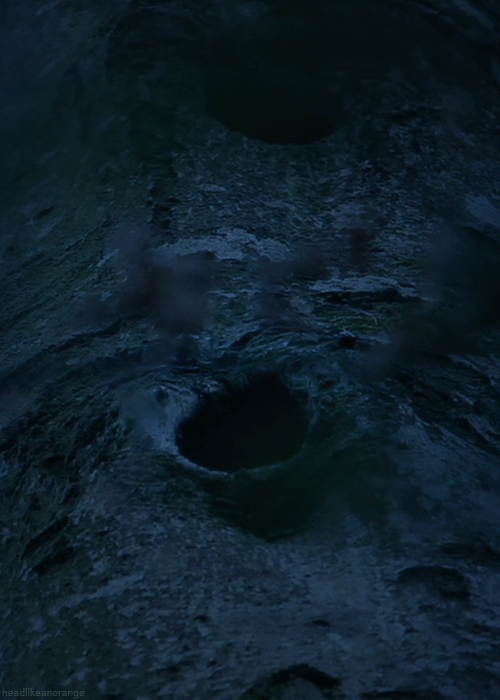



Enjoy some nature gifs in HD. [Click images to enlarge.]
"We've picked out a few favorites from Head Like An Orange, home of hundreds of amazing nature GIFs.
Marinus is a 28-year-old from the Netherlands, and he makes GIFs. But not just any GIFs: his Tumblr, Head Like An Orange, is a collection of some of nature's most stunning, weirdest, sweetest, and funniest moments. At least, they are the best moments captured on film, put into TV shows, and edited down into short, spellbinding loops.
Are the ones we've picked out here the best GIFs on Marinus's blog? We don't know—there are hundreds to choose from, and they are all wonderful. But here are a few of the highlights."
rhamphotheca: Why Are So Many Deep Sea Creatures Red? Red light...

Why Are So Many Deep Sea Creatures Red?
Red light does not reach ocean depths, so deep-sea animals that are red actually appear black and thus are less visible to predators and prey.
As you travel from surface waters to deeper waters, the quantity of light changes; it decreases with depth. The quality of light also varies with depth. Sunlight contains all of the colors of our visible spectrum (red, orange, yellow, green, blue, and violet). These colors combined together appear white.
Red light has the longest wavelength and, therefore, the least amount of energy in the visible spectrum. Wavelength decreases and energy increases as you move from red to violet light across the spectrum in the following order: red, orange, yellow, green, blue, and violet…
(read more: NOAA Ocean Explorer)
Image: The deep-sea scyphozoan jellyfish, Atolla wyvillei, as seen under white light. Image courtesy of Edith A. Widder, Operation Deep Scope 2005 Exploration, NOAA-OE.
spaceplasma: Colossal Hot Cloud Envelopes Colliding...

Optical view of the NGC 6240

Composite (X-ray & optical) view of the NGC 6240.
Colossal Hot Cloud Envelopes Colliding Galaxies
- An enormous cloud of hot gas is surrounding two merging spiral galaxies.
- This gas reservoir contains the mass of 10 billion Suns, spans 300,000 light years, and radiates at more 7 million degrees.
- X-rays from Chandra (purple) have been combined with optical data from Hubble to make this composite image.
- A burst of star formation that lasted for at least 200 million years may be responsible for this extra large cloud of hot gas.
Scientists have used Chandra to make a detailed study of an enormous cloud of hot gas enveloping two large, colliding galaxies. This unusually large reservoir of gas contains as much mass as 10 billion Suns, spans about 300,000 light years, and radiates at a temperature of more than 7 million degrees Kelvin.
This giant gas cloud, which scientists call a "halo," is located in the system called NGC 6240. Astronomers have long known that NGC 6240 is the site of the merger of two large spiral galaxies similar in size to our own Milky Way. Each galaxy contains a supermassive black hole at its center. The black holes are spiraling toward one another, and may eventually merge to form a larger black hole.
Another consequence of the collision between the galaxies is that the gas contained in each individual galaxy has been violently stirred up. This caused a baby boom of new stars that has lasted for at least 200 million years. During this burst of stellar birth, some of the most massive stars raced through their evolution and exploded relatively quickly as supernovas.
The scientists involved with this study argue that this rush of supernova explosions dispersed relatively high amounts of important elements such as oxygen, neon, magnesium, and silicon into the hot gas of the newly combined galaxies. According to the researchers, the data suggest that this enriched gas has slowly expanded into and mixed with cooler gas that was already there.
During the extended baby boom, shorter bursts of star formation have occurred. For example, the most recent burst of star formation lasted for about five million years and occurred about 20 million years ago in Earth's timeframe. However, the authors do not think that the hot gas was produced just by this shorter burst.
What does the future hold for observations of NGC 6240? Most likely the two spiral galaxies will form one young elliptical galaxy galaxy over the course of millions of years. It is unclear, however, how much of the hot gas can be retained by this newly formed galaxy, rather than lost to surrounding space. Regardless, the collision offers the opportunity to witness a relatively nearby version of an event that was common in the early Universe when galaxies were much closer together and merged more often.
In this new composite image of NGC 6240, the X-rays from Chandra that reveal the hot gas cloud are colored purple. These data have been combined with optical data from the Hubble Space Telescope, which shows long tidal tails from the merging galaxies, extending to the right and bottom of the image.
Credit: X-ray (NASA/CXC/SAO/E.Nardini et al); Optical (NASA/STScI)
jtotheizzoe: This is where all our greenhouse gases come from …...

This is where all our greenhouse gases come from … sources, users and the volume of gases. Also check a more in-depth analysis at Grist.
One thing to remember is that while a gas like methane is only 1/5th of the emission volume, its greenhouse effect is 20 times that of CO2, pound for pound.
heythereuniverse: Needle playing a record | Victrola Coffee...

Needle playing a record | Victrola Coffee Roasters
Coloured scanning electron micrograph (SEM) of the needle (stylus) of a record player in a groove on a record. A record is used to store sound. It is produced by a machine with a head which vibrates in time to the sound being recorded. This cuts a groove in the record which varies according to the vibrations. A needle can then reproduce these vibrations as it runs along the groove and these, when amplified, produce the original sound.
shadyperfection: "They presume that, if the math is not coming...



"They presume that, if the math is not coming easy, that therefore you'll never learn it, and I meant it literally that math is the language of the universe and it's like any other language, especially a language that does not share the Roman alphabet. So, for example, if you wanted to study chinese it looks completely intractable, at first.
And so, and you could ask the question, "How long does it take one to become fluent in Chinese if you are not Chinese, yourself?"
And so, it can take years and five years, almost 10 years if you never go to China. You go to China for maybe five years of intensive exposure and you've never done that with math. Imagine that level of exposure to math. What kind of fluency you will have at the other end of that pipeline?
So, at least give yourself the opportunity that any person learning a foreign language would give themselves, before you turn around and say you're not good at math."
— Neil deGrasse Tyson
"Nobody ever figures out what life is all about, and it doesn't matter. Explore the world. Nearly..."
"Nobody ever figures out what life is all about, and it doesn't matter. Explore the world. Nearly everything is really interesting if you go into it deeply enough."- Richard P. Feynman (via larmoyante)
cozydark: New Glimpse Into the Mind of Ramanujan | December...


New Glimpse Into the Mind of Ramanujan |
December 22 marks the 125th anniversary of the birth of Srinivasa Ramanujan, an Indian mathematician renowned for somehow intuiting extraordinary numerical patterns and connections without the use of proofs or modern mathematical tools. A devout Hindu, Ramanujan said that his findings were divine, revealed to him in dreams by the goddess Namagiri.
"I wanted to do something special, in the spirit of Ramanujan, to mark the anniversary," says Emory mathematician Ken Ono. "It's fascinating to me to explore his writings and imagine how his brain may have worked. It's like being a mathematical anthropologist."
Ono, a number theorist whose work has previously uncovered hidden meanings in the notebooks of Ramanujan, set to work on the 125th-anniversary project with two colleagues and former students: Amanda Folsom, from Yale, and Rob Rhoades, from Stanford.
The result is a formula for mock modular forms that may prove useful to physicists who study black holes. The work, which Ono recently presented at the Ramanujan 125 conference at the University of Florida, also solves one of the greatest puzzles left behind by the enigmatic Indian genius.
While on his death-bed in 1920, Ramanujan wrote a letter to his mentor, English mathematician G. H. Hardy. The letter described several new functions that behaved differently from known theta functions, or modular forms, and yet closely mimicked them. Ramanujan conjectured that his mock modular forms corresponded to the ordinary modular forms earlier identified by Carl Jacobi, and that both would wind up with similar outputs for roots of 1.
No one at the time understood what Ramanujan was talking about. "It wasn't until 2002, through the work of Sander Zwegers, that we had a description of the functions that Ramanujan was writing about in 1920," Ono says. continue reading
Planetary Resources infographic about high value materials in...

Planetary Resources infographic about high value materials in asteroids that they wish to exploit to bring the dreams of the 1950's and 1960's into being.
Want to be involved? Donate to the Kickstarter appeal for the Arkyd 100 Space Telescope, controllable by YOU.
http://www.kickstarter.com/projects/1458134548/arkyd-a-space-telescope-for-everyone-0
sagansense: Carl Sagan: A Message To Humanity A wonderful video...
Carl Sagan: A Message To Humanity
A wonderful video compilation of some of Carl's most powerful and chillingly [still] relevant words. Introduce someone to Carl Sagan today and utilize this video. These are prophetic words from a human being who truly "spoke for Earth".
Stay Curious. Watch and share the Sagan Series by Reid Gower; change someone's life today.
stellar-indulgence: Opalized Fossils These are no ordinary...
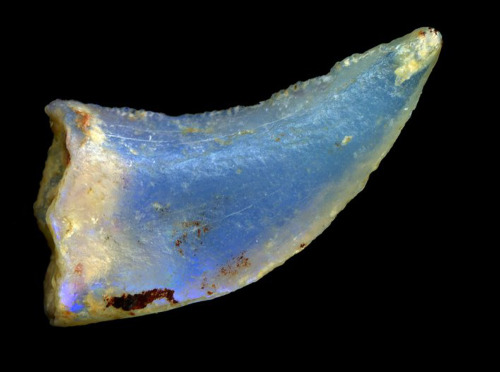
Opalized dinosaur tooth
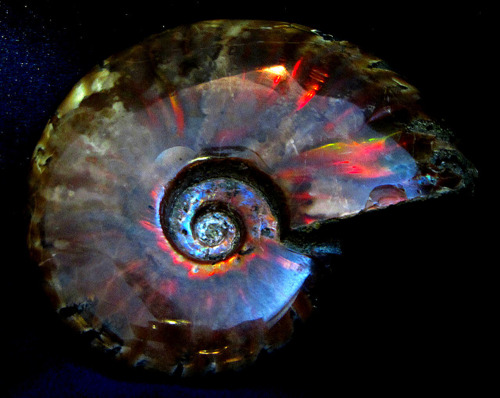
Opalized ammonite
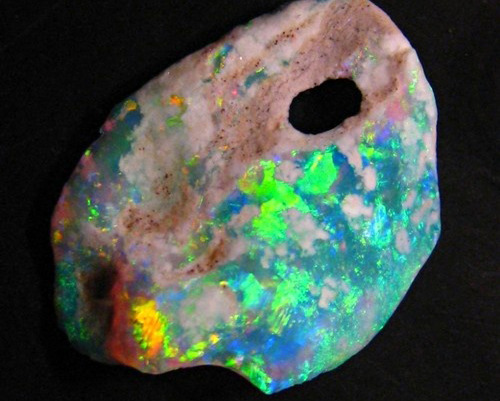
Opalized shell

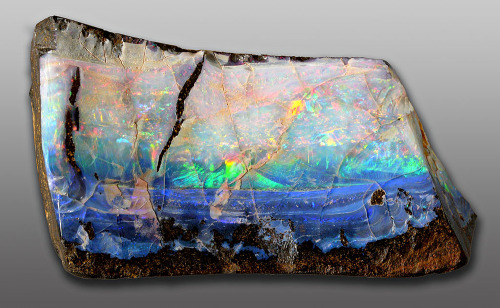
dinosaur bone

Opalized wood
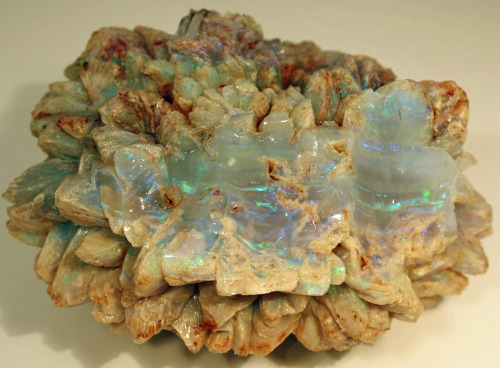
Opalized pineapple

Opalized mussel shell

Belemnite. An extinct order of cephalopods. Superficially squid-like.
These are no ordinary fossils (if there is such a thing): these incredible relics are made of solid opal, sometimes with rainbows of shimmering color. Australia is the only place on Earth where opalized animal fossils are found. These fossils are of global scientific interest and are among the most beautiful and valuable in the world.
How do opalized fossils form?
Opal forms in cavities within rocks. If a cavity has formed because a bone, shell or pine cone was buried in the sand or clay that later became the rock, and conditions are right for opal formation, then the opal forms a fossil replica of the original object that was buried. We get opalized fossils of two kinds:
i. Internal details not preserved: Opal starts as a solution of silica in water. If the silica solution fills an empty space left by a shell, bone etc that has rotted away - like jelly poured into a mould - it may harden to form an opalized cast of the original object. Most opalized shell fossils are 'jelly mould' fossils - the outside shape is beautifully preserved, but the opal inside doesn't record any of the creature's internal structure.ii. Internal details preserved: If the buried organic material hasn't rotted away and a silica solution soaks into it, when the silica hardens it may form an opal replica of the internal structure of the object. This happens sometimes with wood or bone.
Images in this order: Opalized Dinosaur tooth, Ammonite,Shell x2, Dinosaur bone, Wood, Pineapple, Mussel shell, Belemnite. Click on each to view in more detail.
spaceplasma: Newly Found Truck-Sized Asteroid to Whiz by Earth...

Newly Found Truck-Sized Asteroid to Whiz by Earth June 8A truck-sized asteroid just discovered yesterday (Thursday, June 6) will give Earth a relatively close shave later today/early tomorrow, depending on your time zone. Asteroid 2013 LR6 is somewhere between 5- 16 meters (16 to 54 feet) in diameter and will be flying by at only about 111,000 kilometers (69,000 mi, 0.29x Lunar Distances) from Earth at 4:43UTC/12:43AM EDT on June 8, 2013.
This is similar in size to the space rock that exploded over Russia back in February of this year. The Russian asteroid was about 15 meters (50 feet) in diameter before it exploded in an airburst event about 20-25 km (12-15 miles) above Earth's surface.
Find out how you can watch the flyby live online, below.
This flyby is not at close as February's 2012 DA14 flyby, but it indeed is quite close on by Solar System standards. It will be speeding by 9.8 km a second (6.14 mi/s). The asteroid was first spotted by the Catalina Sky Survey and now several other observatories have made follow-up observations to verify and help determine its size and orbit.According to the Minor Planet Center's Twitter feed, 2013 LR6 is the 167th minor planetary object discovered so far in the month of June 2013! That is incredible, and as astronomer Nick Howes said via Twitter, "That number should give people a good heads up as to why searching is important."
According to our David Dickinson, 2013 LR6 will be plunging thru the constellation Vela at closest approach tonight, but it will be a faint one, as it won't break +13 magnitude.
Since this discovery is so new, the Gianluca Masi an the Virtual Telescope Project in Italy has put together a last-minute opportunity to watch the flyby live, online via their telescopes.
The online event is scheduled for June 7, 2013 at 21:30 UTC. To watch, go to the Virtual Telescope project's webcast page.
Credit: Nancy Atkinson
sagansense: Neil deGrasse Tyson @ UB | What NASA Means to...
Neil deGrasse Tyson @ UB | What NASA Means to America's Future
Astrophysicist Neil deGrasse Tyson, a Distinguished Speaker at the University at Buffalo, answered a student's question about federal cutbacks to NASA funding. Tyson is host of the PBS series NOVA scienceNOW and director of New York City's Hayden Planetarium.
CellCraft
CellCraft:CellCraft is a realistic cellular simulation that challenges players to learn about and manipulate a cell and its various components in order to survive.
GUYS THIS GAME IS ACTUALLY SO MUCH FUN YOU DON'T EVEN KNOW
YOU GET TO BUILD A CELL AND MAKE ITS ORGANELLES AND FIGHT OFF VIRUSES AND IT'S JUST A GREAT WAY TO STUDY AND HAVE FUN AT THE SAME TIME
astronomy-to-zoology: Black Sea Nettle (Chrysaora achlyos) Also...


Black Sea Nettle (Chrysaora achlyos)
Also known as the black jellyfish, the black sea nettle is a species of true jellyfish found throughout the Western seaboard of the Pacific Ocean. Like other scyphozoan jellies the black sea nettle is carnivorous and will feed on any plankton that swim into its stinging tentacles. Its sting is powerful enough to kill or stun small animals but will only cause a painful sting that will last for about forty minutes in humans.
Phylogeny
Animalia-Cnidaria-Scyphozoa-Semaeostomaeae-Pelagiidae-Chrysaora-achlyos
biocanvas: Nearly 85% of cancers derive from epithelial cells...

Nearly 85% of cancers derive from epithelial cells that line almost every organ in the human body. When cancers become aggressive, they can lose their epithelial characteristics and become more motile. Motile cancerous cells can result in cancer metastasis. To understand the process by which epithelial cells become more motile, the fruit fly egg chamber is an excellent model system as groups of epithelial cells detach and migrate during egg development. Seen here are several egg chambers from Drosophila melanogaster.
Image by Denise Montell.
astronemma: Mars Rover Opportunity Slips Into Standby Mode,...

Mars Rover Opportunity Slips Into Standby Mode, NASA Says
NASA's long-lived Opportunity Mars rover has gone into a self-imposed standby mode on the Red Planet, the robot's handlers say.
Mission controllers for Opportunity, which landed on Mars in January 2004, first learned of the issue on Saturday (April 27). On that day, the rover got back in touch after a nearly three-week communication moratorium caused by an unfavorable planetary alignment called a Mars solar conjunction, in which Mars and Earth are on opposite sides of the sun.
The Opportunity rover apparently put itself into standby on April 22 after sensing a problem during a routine camera check, mission managers said.
Read more: [x]
astrodidact: "BX442" —The First Spiral Galaxy in the...

"BX442" —The First Spiral Galaxy in the Universe?
It seems that, so far, it is: In July of 2012, astronomers observed a spiral galaxy in the early universe, billions of years before many otherspiral galaxiesformed while using the Hubble Space Telescope. They were taking pictures of about 300 very distant galaxies in the early universe to study their properties. This distant spiral galaxy they discovered existed roughly three billion years after the Big Bang, and light from this part of the universe has been traveling to Earth for about 10.7 billion years.
"As you go back in time to the early universe, galaxies look really strange, clumpy and irregular, not symmetric," said Alice Shapley, a UCLA associate professor of physics and astronomy, and co-author of the study. "The vast majority of old galaxies look like train wrecks. Our first thought was, why is this one so different, and so beautiful?""BX442 looks like a nearby galaxy, but in the early universe, galaxies were colliding together much more frequently," she said. "Gas was raining in from the intergalactic medium and feeding stars that were being formed at a much more rapid rate than they are today; black holes grew at a much more rapid rate as well. The universe today is boring compared to this early time."
Galaxies in today's universe divide into various types, including spiral galaxies like our own Milky Way, which are rotating disks of stars and gas in which new stars form, and elliptical galaxies, which include older, redder stars moving in random directions. The mix of galaxy structures in the early universe is quite different, with a much greater diversity and larger fraction of irregular galaxies, Shapley said.
"The fact that this galaxy exists is astounding," said David Law, lead author of the study and Dunlap Institute postdoctoral fellow at the University of Toronto's Dunlap Institute for Astronomy & Astrophysics. "Current wisdom holds that such 'grand-design' spiral galaxies simply didn't exist at such an early time in the history of the universe." A 'grand design' galaxy has prominent, well-formed spiral arms.
The galaxy, which goes by the not very glamorous name of BX442, is quite large compared with other galaxies from this early time in the universe; only about 30 of the galaxies that Law and Shapley analyzed are as massive as this galaxy.
To gain deeper insight into their unique image of BX442, Law and Shapley went to the W.M. Keck Observatory atop Hawaii's dormant Mauna Kea volcano and used a unique state-of-the-science instrument called the OSIRIS spectrograph, which was built by James Larkin, a UCLA professor of physics and astronomy. They studied spectra from some 3,600 locations in and around BX442, which provided valuable information that enabled them to determine that it actually is a rotating spiral galaxy — and not, for example, two galaxies that happened to line up in the image.
"We first thought this could just be an illusion, and that perhaps we were being led astray by the picture," Shapley said. "What we found when we took the spectral image of this galaxy is that the spiral arms do belong to this galaxy. It wasn't an illusion. We were blown away." Law and Shapley also see some evidence of an enormous black hole at the center of the galaxy, which may play a role in the evolution of BX442.
Why does BX442 look like galaxies that are so common today but were so rare back then?
Law and Shapley say the answer may have to do with a companion dwarf galaxy, which the OSIRIS spectrograph reveals as a blob in the upper left portion of the image, and the gravitational interaction between them. Support for this idea is provided by a numerical simulation conducted by Charlotte Christensen, a postdoctoral scholar at the University of Arizona and a co-author of the research in Nature. Eventually the small galaxy is likely to merge into BX442, Shapley said.
Law, a former Hubble postdoctoral fellow at UCLA, and Shapley will continue to study BX442.
"We want to take pictures of this galaxy at other wavelengths," Shapley said. "That will tell us what type of stars are in every location in the galaxy. We want to map the mixture of stars and gas in BX442."
Shapley said that BX442 represents a link between early galaxies that are much more turbulent and the rotating spiral galaxies that we see around us. "Indeed, this galaxy may highlight the importance of merger interactions at any cosmic epoch in creating grand design spiral structure," she said.
Studying BX442 is likely to help astronomers understand how spiral galaxies like the Milky Way form, Shapley concluded.
The image at the top of the page ian an artist's conception of the farthest spiral galaxy ever seen; in a Hubble/Keck image (inset), the blob at upper left is a companion galaxy whose gravity may have sparked the spiral structure. Credit: (left) David Law; (right) Joe Bergeron, DunlapInstitute for Astronomy and Astrophysics
The Daily Galaxy via UCLA News and Nature.com















No comments:
Post a Comment